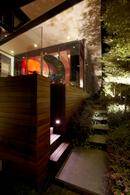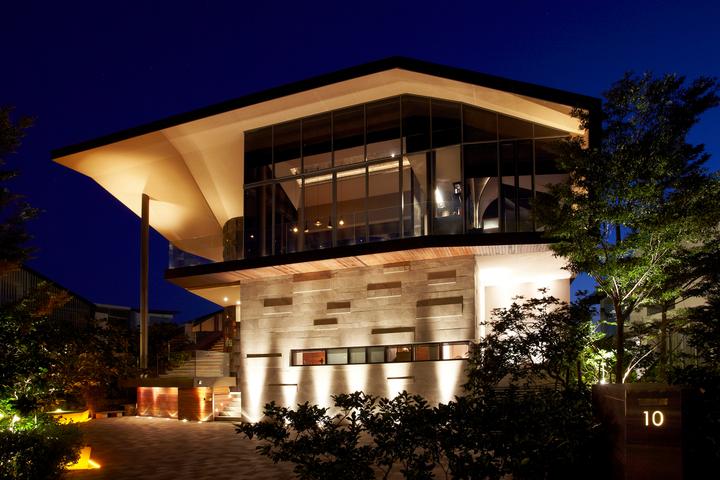1 / 13













Project Details
The design of the house is developed around the central theme of reconciling generational differences and allowing space for individual freedom between members of the family.
Intentionally, the house is broken into a series of disparate units housing different function, not unlike a series of floating pavilions. With each detached unit operating independently, it is possible to re-examine the programmatic relationship between them and reconfigure and subvert conventional notion of space planning.
Following the above intent, two key strategies are conceived to separate and bind various programmes simultaneously:
i. A central courtyard - with a swimming pool.
ii. Interconnectivity - A looped circulation by way of a series of interconnected balconies and terraces.
The plan layout of the house takes a deliberate approach of reversing the traditional layout by elevating the formal spaces of the house to the 2nd floor while keeping the private domestic realm of the house to the ground.
In a gesture of festive celebration, one is greeted upon arrival by a luminous light drum framed in a lofty vestibule beneath a soaring roof.
We choreograph the visitor to ascend a grand staircase that wraps around the luminous light drum. Tea light candles can be placed alongside the drum intricate envelope as a romanticized gesture of celebrating the Indian culture before one is led to the formal living and dining room. The sense of arrival at the living room / dining room is eventually concluded with the voluminous ceiling of the spaces and impressive view of the lush green on the State land and the waterways beyond.
In contrast to the formal spaces above, the private domain of the teenage children assumes a low profile. Tucked away from the scrutiny of the parents, the rooms are almost completely hidden away, kept in close contact with lush vegetation on the ground but with easy access to the lap pool. The need for privacy notwithstanding, common domestic areas such as the family room or kitchen have been allocated on the opposite side of the pool to provide a platform for interaction between family member.
In attempt to further differentiate from the formal spaces of the house, the master bedroom with its attached meditation attic is deliberately elevated to half a floor higher. This gives the master bedroom an opportunity maximize the desirable view of the horizon but remain buffered from the formal areas by sloping gardens with lush vegetation and long corridors.
Overall , the composition of house as a whole is legible from the outside as one contiguous fabric - like envelope, forming simultaneously green terraces, balconies, walkways and shielding walls ( facing west ) and the roof. The flowing envelope schemes to bind various segregated spaces accommodating various program into a unified whole.
With this stroke, we thought we have given the Taj Mahal a different spin and the client was happy.The design of the house is developed around the central theme of reconciling generational differences and allowing space for individual freedom between members of the family.
Intentionally, the house is broken into a series of disparate units housing different function, not unlike a series of floating pavilions. With each detached unit operating independently, it is possible to re-examine the programmatic relationship between them and reconfigure and subvert conventional notion of space planning.
Following the above intent, two key strategies are conceived to separate and bind various programmes simultaneously:
i. A central courtyard - with a swimming pool.
ii. Interconnectivity - A looped circulation by way of a series of interconnected balconies and terraces.
The plan layout of the house takes a deliberate approach of reversing the traditional layout by elevating the formal spaces of the house to the 2nd floor while keeping the private domestic realm of the house to the ground.
In a gesture of festive celebration, one is greeted upon arrival by a luminous light drum framed in a lofty vestibule beneath a soaring roof.
We choreograph the visitor to ascend a grand staircase that wraps around the luminous light drum. Tea light candles can be placed alongside the drum intricate envelope as a romanticized gesture of celebrating the Indian culture before one is led to the formal living and dining room. The sense of arrival at the living room / dining room is eventually concluded with the voluminous ceiling of the spaces and impressive view of the lush green on the State land and the waterways beyond.
In contrast to the formal spaces above, the private domain of the teenage children assumes a low profile. Tucked away from the scrutiny of the parents, the rooms are almost completely hidden away, kept in close contact with lush vegetation on the ground but with easy access to the lap pool. The need for privacy notwithstanding, common domestic areas such as the family room or kitchen have been allocated on the opposite side of the pool to provide a platform for interaction between family member.
In attempt to further differentiate from the formal spaces of the house, the master bedroom with its attached meditation attic is deliberately elevated to half a floor higher. This gives the master bedroom an opportunity maximize the desirable view of the horizon but remain buffered from the formal areas by sloping gardens with lush vegetation and long corridors.
Overall , the composition of house as a whole is legible from the outside as one contiguous fabric - like envelope, forming simultaneously green terraces, balconies, walkways and shielding walls ( facing west ) and the roof. The flowing envelope schemes to bind various segregated spaces accommodating various program into a unified whole.
With this stroke, we thought we have given the Taj Mahal a different spin and the client was happy.Read MoreHide
Year of Completion
2011
Interior Style
Contemporary
Works included
Carpentry
Flooring
Hacking
Tiling
False Ceiling
Aircon
Electrical Rewiring
Plumbing
Painting
Feature Wall
Wallpaper














